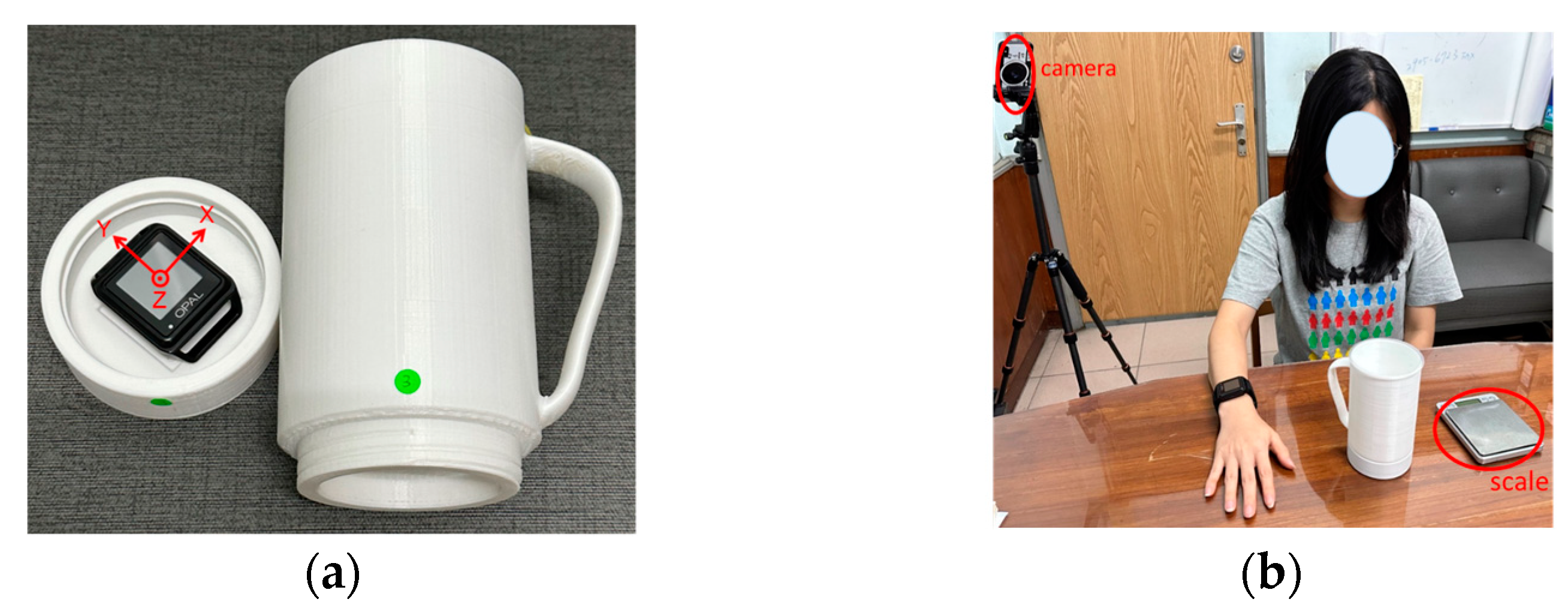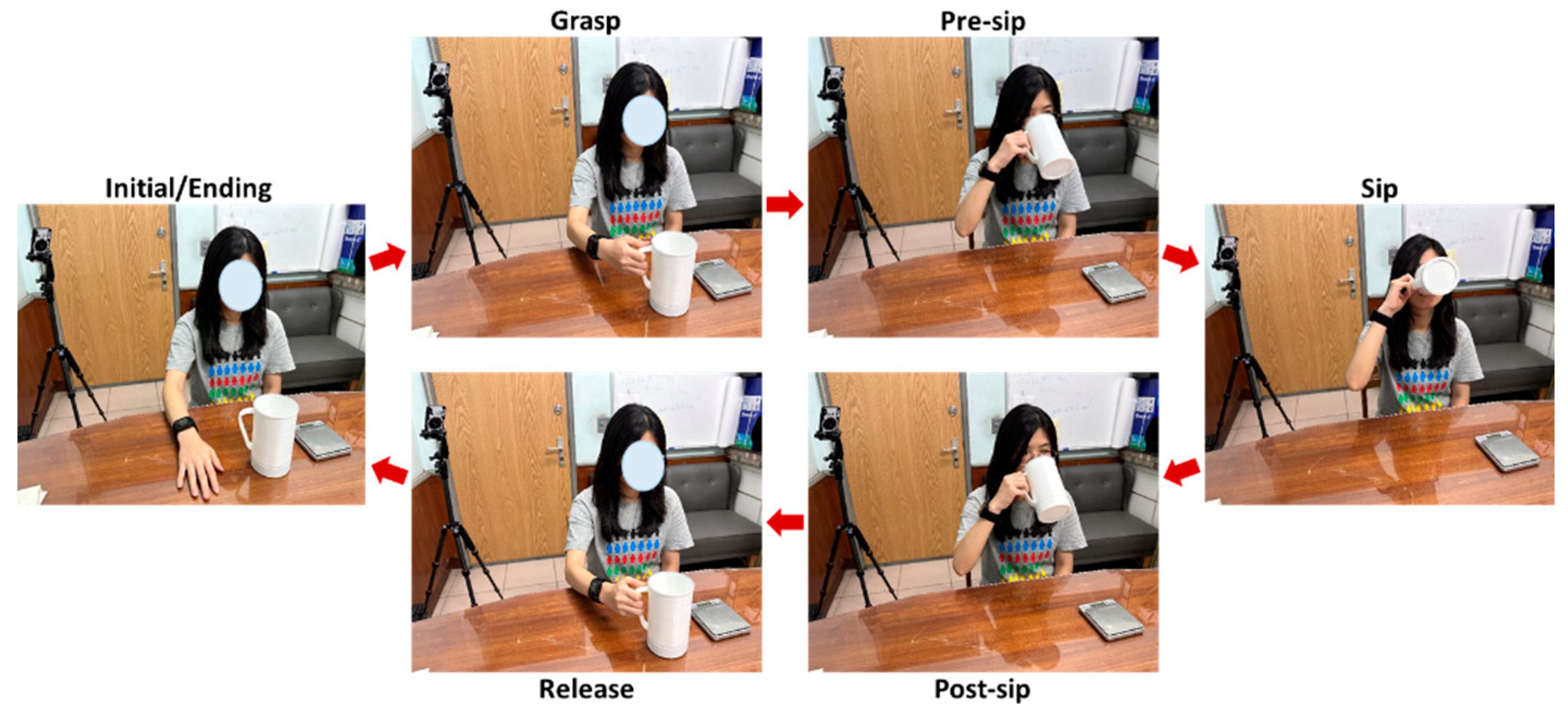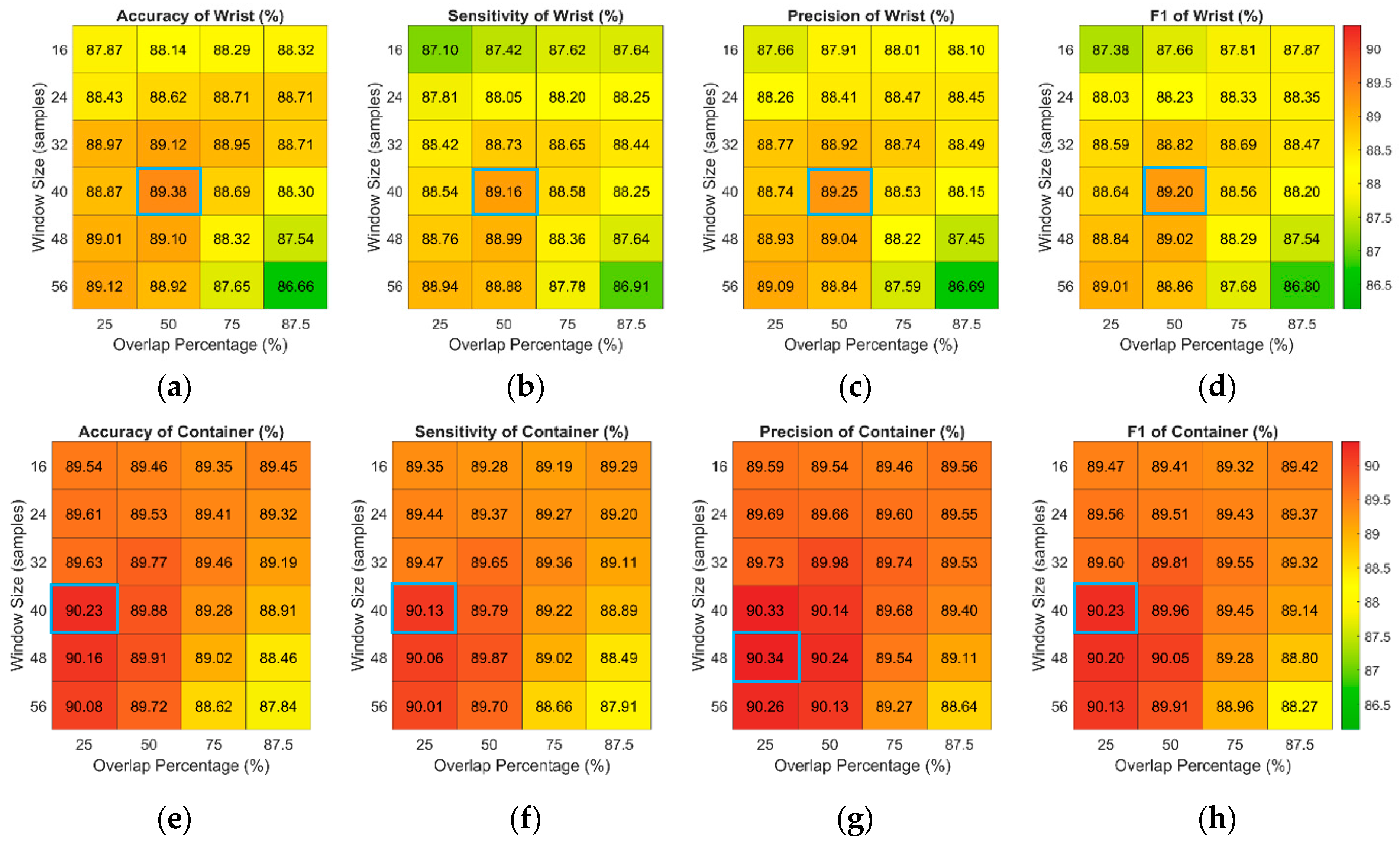An Analysis of Fluid Intake Assessment Approaches for Fluid Intake Monitoring System
Abstract
:1. Introduction
- Experimental scenario: This study designs the experimental scenario for unbiased conditions and the same foothold. In the experiment, the motion data are collected from sensors on the wrist and in the container simultaneously during the whole drinking activity. This study analyzes and compares performances of two approaches through synchronous data collection for providing reliable referenced information.
- Consideration of fill levels and sip sizes: To enhance the reliability and robustness of fluid intake assessment, this study factors in variables such as fill levels in containers and sip sizes. These factors can influence the tilt of the container and the rotation of the wrist, but they have often been overlooked in previous research. This study conducts an in-depth analysis of how fill levels and sip sizes affect the estimation performance of both approaches.
2. Related Work
3. Experimental Protocol
4. Methodology
4.1. Gesture Recognition
4.2. Volume Estimation
4.3. Performacne Evaluation
5. Results
5.1. Gesture Recognition
5.2. Volume Estimation
6. Discussion
7. Conclusions
Author Contributions
Funding
Institutional Review Board Statement
Informed Consent Statement
Data Availability Statement
Conflicts of Interest
References
- Gandy, J.; Martinez, H.; Guelinckx, I.; Moreno, L.A.; Bardosono, S.; Salas-Salvadó, J.; Kavouras, S.A. Relevance of assessment methods for fluid intake. Ann. Nutr. Metab. 2016, 68, 1–5. [Google Scholar] [CrossRef] [PubMed]
- Hamatani, T.; Elhamshary, M.; Uchiyama, A.; Higashino, T. FluidMeter: Gauging the human daily fluid intake using smartwatches. Proc. ACM Interact. Mob. Wearable Ubiquitous Technol. 2018, 2, 1–25. [Google Scholar] [CrossRef]
- Kavouras, S.A.; Anastasiou, C.A. Water physiology: Essentiality, metabolism, and health implications. Nutr. Today 2010, 45, S27–S32. [Google Scholar] [CrossRef]
- Armstrong, L.E.; Johnson, E.C. Water intake, water balance, and the elusive daily water requirement. Nutrients 2018, 10, 1928. [Google Scholar] [CrossRef] [PubMed]
- EFSA Panel on Dietetic Products, Nutrition, and Allergies (NDA). Scientific opinion on dietary reference values for water. EFSA J. 2010, 8, 1459. [Google Scholar]
- Institute of Medicine. DRI, Dietary Reference Intakes for Water, Potassium, Sodium, Chloride, and Sulfate; National Academy Press: Washington, DC, USA, 2004. [Google Scholar]
- Liaqat, S.; Dashtipour, K.; Arshad, K.; Ramzan, N. Non invasive skin hydration level detection using machine learning. Electronics 2020, 9, 1086. [Google Scholar] [CrossRef]
- Shaheen, N.A.; Alqahtani, A.A.; Assiri, H.; Alkhodair, R.; Hussein, M.A. Public knowledge of dehydration and fluid intake practices: Variation by participants’ characteristics. BMC Public Health 2018, 18, 1346. [Google Scholar] [CrossRef]
- Warren, J.; Guelinckx, I.; Livingstone, B.; Potischman, N.; Nelson, M.; Foster, E.; Holmes, B. Challenges in the assessment of total fluid intake in children and adolescents: A discussion paper. Eur. J. Nutr. 2018, 57, 43–51. [Google Scholar] [CrossRef]
- Cohen, R.; Fernie, G.; Roshan Fekr, A. Fluid intake monitoring systems for the elderly: A review of the literature. Nutrients 2021, 13, 2092. [Google Scholar] [CrossRef]
- Chang, Y.C.; Sheikh, A.R.; Chua, J.L.; Tham, J.S. Visual based dining activities detection in ambient assisted living. In Proceedings of the 2015 IEEE International Conference on Consumer Electronics-Taiwan, Taipei, Taiwan, 6–8 June 2015; pp. 494–495. [Google Scholar]
- Kassim, M.F.; Mohd, M.N.H.; Tomari, M.R.M.; Suriani, N.S.; Zakaria, W.N.W.; Sari, S. A non-invasive and non-wearable food intake monitoring system based on depth sensor. Bull. Electr. Eng. Inform. 2020, 9, 2342–2349. [Google Scholar] [CrossRef]
- Watanabe, T.; Shimokakimoto, T.; Jayatilake, D.; Inoue, M.; Suzuki, K. A portable sensor sheet for measuring the eating pace in meal assistance care. In Proceedings of the 2019 41st Annual International Conference of the IEEE Engineering in Medicine and Biology Society (EMBC), Berlin, Germany, 23–27 July 2019; pp. 4297–4300. [Google Scholar]
- Cohen, R.; Fernie, G.; Fekr, A.R. Contactless Drink Intake Monitoring Using Depth Data. IEEE Access 2023, 11, 12218–12225. [Google Scholar] [CrossRef]
- Ortega Anderez, D.; Lotfi, A.; Pourabdollah, A. A deep learning based wearable system for food and drink intake recognition. J. Ambient. Intell. Humaniz. Comput. 2021, 12, 9435–9447. [Google Scholar] [CrossRef]
- Gomes, D.; Sousa, I. Real-Time drink trigger detection in free-living conditions using inertial sensors. Sensors 2019, 19, 2145. [Google Scholar] [CrossRef] [PubMed]
- Griffith, H.; Shi, Y.; Biswas, S. A dynamic partitioning algorithm for sip detection using a bottle-attachable IMU sensor. Int. J. Adv. Comput. Sci. Appl. 2019, 10, 1–10. [Google Scholar] [CrossRef]
- Griffith, H.; Shi, Y.; Biswas, S. A Container-Attachable Inertial Sensor for Real-Time Hydration Tracking. Sensors 2019, 19, 4008. [Google Scholar] [CrossRef] [PubMed]
- Cohen, R.; Fernie, G.; Roshan Fekr, A. Monitoring fluid intake by commercially available smart water bottles. Sci. Rep. 2022, 12, 4402. [Google Scholar] [CrossRef] [PubMed]
- Zimmermann, C.; Zeilfelder, J.; Bloecher, T.; Diehl, M.; Essig, S.; Stork, W. Evaluation of a smart drink monitoring device. In Proceedings of the 2017 IEEE Sensors Applications Symposium (SAS), Glassboro, NJ, USA, 13–15 March 2017; pp. 1–5. [Google Scholar]
- Kreutzer, J.F.; Deist, J.; Hein, C.M.; Lueth, T.C. Sensor systems for monitoring fluid intake indirectly and directly. In Proceedings of the 2016 IEEE 13th International Conference on Wearable and Implantable Body Sensor Networks (BSN), San Francisco, CA, USA, 14–17 June 2016; pp. 1–6. [Google Scholar]
- Huang, H.-Y.; Hsieh, C.-Y.; Liu, K.-C.; Hsu, S.J.-P.; Chan, C.-T. Fluid Intake Monitoring System Using a Wearable Inertial Sensor for Fluid Intake Management. Sensors 2020, 20, 6682. [Google Scholar] [CrossRef]
- Chun, K.S.; Sanders, A.B.; Adaimi, R.; Streeper, N.; Conroy, D.E.; Thomaz, E. Towards a generalizable method for detecting fluid intake with wrist-mounted sensors and adaptive segmentation. In Proceedings of the 24th International Conference on Intelligent User Interfaces, Marina del Ray, CA, USA, 16–20 March 2019; pp. 80–85. [Google Scholar]
- Griffith, H.; Biswas, S. Container type and fill level classification using a bottle-attachable IMU sensor. In Proceedings of the 2019 IEEE 23rd International Symposium on Consumer Technologies (ISCT), Ancona, Italy, 19–21 June 2019; pp. 147–152. [Google Scholar]
- Liu, K.-C.; Hsieh, C.-Y.; Huang, H.-Y.; Chiu, L.-T.; Hsu, S.J.-P.; Chan, C.-T. Drinking event detection and episode identification using 3D-printed smart cup. IEEE Sens. J. 2020, 20, 13743–13751. [Google Scholar] [CrossRef]
- Amft, O.; Bannach, D.; Pirkl, G.; Kreil, M.; Lukowicz, P. Towards wearable sensing-based assessment of fluid intake. In Proceedings of the 2010 8th IEEE International Conference on Pervasive Computing and Communications Workshops (PERCOM Workshops), Mannheim, Germany, 29 March–2 April 2010; pp. 298–303. [Google Scholar]
- Dehghani, A.; Sarbishei, O.; Glatard, T.; Shihab, E.J. A quantitative comparison of overlapping and non-overlapping sliding windows for human activity recognition using inertial sensors. Sensors 2019, 19, 5026. [Google Scholar] [CrossRef]
- Li, J.-H.; Tian, L.; Wang, H.; An, Y.; Wang, K.; Yu, L.J. Segmentation and recognition of basic and transitional activities for continuous physical human activity. IEEE Access 2019, 7, 42565–42576. [Google Scholar] [CrossRef]
- Alhammad, N.; Al-Dossari, H.J. Dynamic segmentation for physical activity recognition using a single wearable sensor. Appl. Sci. 2021, 11, 2633. [Google Scholar] [CrossRef]
- Nurwulan, N.R.; Jiang, B.C. Window selection impact in human activity recognition. Int. J. Innov. Technol. Interdiscip. Sci. 2020, 3, 381–394. [Google Scholar]






| System Type | Article (Year) | Algorithm | Sensor | Placement/Position | Results |
|---|---|---|---|---|---|
| Wrist-worn-based | Hamatani et al. (2018) [2] | Drinking activity recognition, gesture spotting and intake volume estimation | Smartwatch | Dominant hand | Drinking activity recognition: 83.6% precision and 87.3% sensitivity Sip gesture spotting: 90.7% precision and 96.3% sensitivity Volume estimation: 29.1% MAPE 1 and 15.1% MPE 1 |
| Chun et al. (2019) [23] | Drinking activity detection | Inertial sensor | Left and right wrists | Precision: 90.3% Sensitivity: 91.0% | |
| Gomes and Sousa (2019) [16] | Pre-drinking (hand-to-mouth) movement recognition | Inertial sensor | Dominant wrist | F-score: 97% in an offline validation and 85% in a real-time free-living validation | |
| Huang et al. (2020) [22] | Drinking activity recognition, gesture spotting and intake volume estimation | Inertial sensor | Right wrist | Drinking activity recognition: 94.42% accuracy Gesture spotting: 90.17% sensitivity Volume estimation: 40.11% MAPE 1 | |
| Ortega Anderez et al. (2021) [15] | Eat and drink intake recognition | Accelerometer | Dominant hand | Eat intake recognition: 96.29% accuracy, 87.43% precision, and 95.81% sensitivity Drink intake recognition: 98.73% accuracy, 92.98% precision, and 89.83% sensitivity | |
| Smart-container-based | Griffith et al. (2019) [18] | Micro-event partitioning and volume estimation | Inertial sensor | Bottle | Volume estimation: 52.39% MAPE 1 |
| Griffith et al. (2019) [24] | Container type and fill level classification | Inertial sensor | Bottle, glass and mug | Container type classification: 97.3% and 77.3% accuracy at the two fill levels considered Fill level classification: 100% accuracy in glass and mug container, and 98.0% accuracy in bottle | |
| Liu et al. (2020) [25] | Drinking event detection and episode identification | Inertial sensor | 3D-printed smart cup | Event identification: 89.92% and 85.88% F-measure in event-defined and frame-defined evaluation approaches | |
| Cohen et al. (2022) [19] | Intake volume estimation | Capacitive or pressure sensors | Bottle | commercial bottle: H2Opal: −2.10% MPE 1 HidrateSpark steel: −16.11% MPE 1 HidrateSpark 3: −14.9% MPE 1 Thermos Smart Lid: 14.64% MPE 1 |
| Feature | Description |
|---|---|
| – | Mean of tri-axial acceleration, angular velocity, angular acceleration, and inclination |
| – | Standard deviation of tri-axial acceleration, angular velocity, angular acceleration, and inclination |
| – | Variance of tri-axial acceleration, angular velocity, angular acceleration, and inclination |
| – | Maximum of tri-axial acceleration, angular velocity, angular acceleration, and inclination |
| – | Minimum of tri-axial acceleration, angular velocity, angular acceleration, and inclination |
| – | Range of tri-axial acceleration, angular velocity, angular acceleration, and inclination |
| – | Skewness of tri-axial acceleration, angular velocity, angular acceleration, and inclination |
| – | Kurtosis of tri-axial acceleration, angular velocity, angular acceleration, and inclination |
| Feature | Description |
|---|---|
| Duration | |
| – | Average inclination in 3 directions |
| – | Maximum inclination in 3 directions |
| – | Integral of inclination in 3 directions |
| – | Number of samples with inclination over 𝑘 degree in 3 directions 𝑘 ∈ {10°, 20°, 30°, 40°, 50°, 60°, 70°, 80°, 90°} |
| – | Number of samples with normalized inclination over p percent of maximum inclination in 3 directions p ∈ {10%, 20%, 30%, 40%, 50%, 60%, 70%, 80%, 90%} |
| Fill level |
| Wrist-Worn-Based Approach | Smart-Container-Based Approach | |||
|---|---|---|---|---|
| SVR-Linear | SVR-Gaussian | SVR-Linear | SVR-Gaussian | |
| 0.49 | 0.01 | 0.84 | 0.17 | |
| MAD (g) | 56.30 | 84.89 | 21.57 | 76.81 |
| MAPE (%) | 29.89 | 45.86 | 11.68 | 42.42 |
| Model | General SVR Model—Linear Kernel | General SVR Model—Gaussian Kernel | ||
|---|---|---|---|---|
| Without Fill Level | With Fill Level | Without Fill Level | With Fill Level | |
| RMSE (g) | 19.54 | 19.81 | 19.45 | 19.33 |
| MAD (g) | 15.33 | 15.60 | 16.56 | 16.54 |
| MAPE (%) | 105.95 | 105.64 | 146.07 | 146.63 |
| Model | Sip-Size-Dependent SVR Model—Linear Kernel | Sip-Size-Dependent SVR Model—Gaussian Kernel | ||||||||||
|---|---|---|---|---|---|---|---|---|---|---|---|---|
| Without Fill Level | With Fill Level | Without Fill Level | With Fill Level | |||||||||
| Large | Medium | Small | Large | Medium | Small | Large | Medium | Small | Large | Medium | Small | |
| RMSE (g) | 10.08 | 7.47 | 7.27 | 10.68 | 7.93 | 6.89 | 9.33 | 6.52 | 6.09 | 9.34 | 6.53 | 6.05 |
| MAD (g) | 8.02 | 6.19 | 5.77 | 8.48 | 6.56 | 5.31 | 7.40 | 5.43 | 5.05 | 7.40 | 5.43 | 5.03 |
| MAPE (%) | 15.88 | 23.76 | 99.99 | 16.69 | 25.13 | 93.37 | 15.52 | 22.21 | 94.45 | 15.54 | 22.24 | 94.18 |
| Model | General SVR Model—Linear Kernel | General SVR Model—Gaussian Kernel | ||
|---|---|---|---|---|
| Without Fill Level | With Fill Level | Without Fill Level | With Fill Level | |
| RMSE (g) | 20.12 | 20.23 | 19.80 | 19.67 |
| MAD (g) | 15.75 | 15.74 | 16.70 | 16.59 |
| MAPE (%) | 106.93 | 106.24 | 131.10 | 133.16 |
| Model | Sip-Size-Dependent SVR Model—Linear Kernel | Sip-Size-Dependent SVR Model—Gaussian Kernel | ||||||||||
|---|---|---|---|---|---|---|---|---|---|---|---|---|
| Without Fill Level | With Fill Level | Without Fill Level | With Fill Level | |||||||||
| Large | Medium | Small | Large | Medium | Small | Large | Medium | Small | Large | Medium | Small | |
| RMSE (g) | 11.55 | 7.83 | 6.79 | 11.73 | 8.08 | 6.98 | 9.57 | 6.83 | 6.40 | 9.44 | 6.76 | 6.28 |
| MAD (g) | 9.17 | 6.38 | 5.86 | 9.32 | 6.58 | 6.08 | 7.63 | 5.73 | 5.28 | 7.53 | 5.65 | 5.22 |
| MAPE (%) | 18.78 | 24.21 | 97.70 | 19.06 | 25.08 | 103.25 | 15.92 | 22.78 | 99.08 | 15.72 | 22.56 | 98.15 |
| Approach | Wrist-Worn-Based Approach | Smart-Container-Based Approach | ||||||
|---|---|---|---|---|---|---|---|---|
| Data | True | Recognized | True | Recognized | True | Recognized | True | Recognized |
| Fill Level | -- | -- | True | Estimated | -- | -- | True | Estimated |
| RMSE (g) | 18.80 | 19.54 | 18.79 | 19.81 | 20.00 | 20.12 | 16.63 | 20.23 |
| MAD (g) | 15.06 | 15.33 | 15.23 | 15.60 | 15.48 | 15.75 | 11.29 | 15.74 |
| MAPE (%) | 96.86 | 105.95 | 102.77 | 105.64 | 93.78 | 106.93 | 71.18 | 106.24 |
Disclaimer/Publisher’s Note: The statements, opinions and data contained in all publications are solely those of the individual author(s) and contributor(s) and not of MDPI and/or the editor(s). MDPI and/or the editor(s) disclaim responsibility for any injury to people or property resulting from any ideas, methods, instructions or products referred to in the content. |
© 2023 by the authors. Licensee MDPI, Basel, Switzerland. This article is an open access article distributed under the terms and conditions of the Creative Commons Attribution (CC BY) license (https://creativecommons.org/licenses/by/4.0/).
Share and Cite
Hsieh, C.-Y.; Huang, H.-Y.; Chan, C.-T.; Chiu, L.-T. An Analysis of Fluid Intake Assessment Approaches for Fluid Intake Monitoring System. Biosensors 2024, 14, 14. https://doi.org/10.3390/bios14010014
Hsieh C-Y, Huang H-Y, Chan C-T, Chiu L-T. An Analysis of Fluid Intake Assessment Approaches for Fluid Intake Monitoring System. Biosensors. 2024; 14(1):14. https://doi.org/10.3390/bios14010014
Chicago/Turabian StyleHsieh, Chia-Yeh, Hsiang-Yun Huang, Chia-Tai Chan, and Li-Tzu Chiu. 2024. "An Analysis of Fluid Intake Assessment Approaches for Fluid Intake Monitoring System" Biosensors 14, no. 1: 14. https://doi.org/10.3390/bios14010014
APA StyleHsieh, C.-Y., Huang, H.-Y., Chan, C.-T., & Chiu, L.-T. (2024). An Analysis of Fluid Intake Assessment Approaches for Fluid Intake Monitoring System. Biosensors, 14(1), 14. https://doi.org/10.3390/bios14010014





